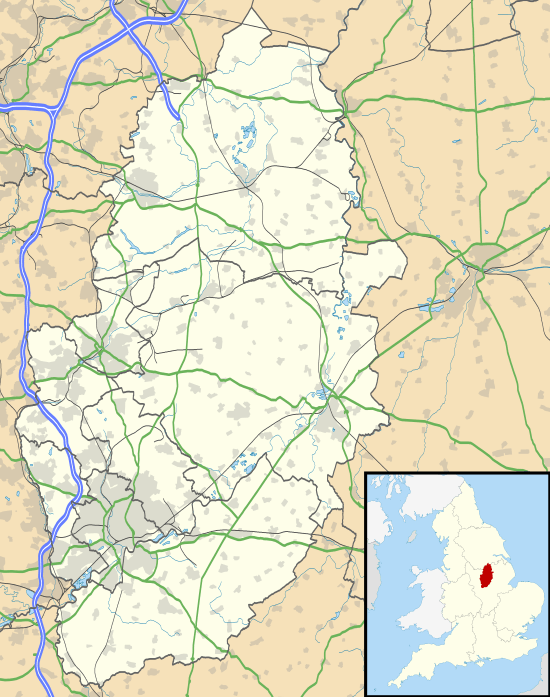Sutton-cum-Granby
Sutton-cum-Granby (known sometimes as Sutton in the Vale) is a small English hamlet in the Rushcliffe borough of Nottinghamshire. It lies in the Vale of Belvoir.
Sutton-cum-Granby
| |
|---|---|
 Sutton-cum-Granby Location within Nottinghamshire | |
| OS grid reference | SK761374 |
| District | |
| Shire county | |
| Region | |
| Country | England |
| Sovereign state | United Kingdom |
| Post town | NOTTINGHAM |
| Postcode district | NG13 |
| Dialling code | 01949 |
| Police | Nottinghamshire |
| Fire | Nottinghamshire |
| Ambulance | East Midlands |
| UK Parliament | |
Location and facilities
Sutton lies about midway between Elton on the Hill and Granby, 14 miles (22.5 km) from Nottingham and from Melton Mowbray, 12 miles (19 km) from Grantham, and 118 miles (190 km) from London. It forms part of the civil and church parish of Granby. The population is currently about 60. In 1742 it was 124, in 1853 152, and in 2001 43.[1] As the population at the 2011 census was less than 100, details are included in the civil parish of Granby. Since December 1919, the member of Parliament (MP) for the Rushcliffe constituency, to which Sutton belongs, is the Conservative Ruth Edwards.[2]
The village has no shops, but there are other businesses: a builder's, a repair garage, and farms. There is a weekday, daytime public transport service, with a bus running every hour to Nottingham via local villages. The nearest railway station is Aslockton, with trains to and beyond Nottingham and Grantham or Skegness.
History
The manor of Sutton, along with at least five others in Nottinghamshire, was held in the 1330s by Thomas de Furnival the elder.[3] By 1520, Sutton belonged to Sir John Savage, but his son, also John, confessed to the murder of Sir John Pauncefort. Henry VIII pardoned him provided that he paid the sum of £4000 to expiate his crime. As a result, the land passed to the Manners family, created earl of Rutland in 1525, and then to their descendants, the earls and from 1638 dukes of Rutland. Much of the village and many of the farms were still, until the 1920s, part of the Rutlands' estate centred on Belvoir Castle, which is a prominent feature on the eastern skyline. During the English Civil War, Oliver Cromwell fought a battle less than a mile from Sutton; human bones have been discovered there as recently as the 1960s.[1]
Sutton is said to be mentioned in the Domesday Book as having a church dedicated to St Ethelburga (or Aubrey), but this has long vanished.[4] However, the purported existence of a church with the same dedication in nearby Langar parish may point to a confusion of some kind.[5] Sutton's small Primitive Methodist Chapel was erected in 1860, but it has been closed for worship since 1995.[1]
The Victorian historian Esdaile described the castle in Sutton as a fortress. William Stevenson described it as "earthworks surrounding a moated homestead". This castle was sited halfway between Sutton and Granby, where there later stood a windmill, pulled down in 1879. A Manuscript Roll of Sutton from about 1586 was sold in 1935.[1]
Modern times
During the Second World War, Sutton received evacuees from Nottingham and later London. Electricity was brought to the village in 1948, and mains water in 1956.[1]
There has never been a public house in what was until recently a predominantly abstinent Methodist community. The village pump on the green and nearby Highfield farmhouse are Grade II listed buildings.[6]
Gallery
 Sutton village green
Sutton village green Sutton Chapel
Sutton Chapel View of Sutton from Granby Lane
View of Sutton from Granby Lane
References
- Robert H. Brown: Memories of my village Sutton-cum-Granby.
- Rushcliffe result. Retrieved 5 January 2020.
- Cornelius Brown: A History of Nottinghamshire (London: Elliot Stock, 1891). Retrieved 4 November 2010.
- Granby cum Sutton Village Plan. Retrieved 5 November 2010.
- Parishes: Langar & Barneston and St. Aubrey's. In: Thoroton's History of Nottinghamshire I: Republished with large additions by John Throsby (1790), pp. 201–209. Retrieved 5 November 2010.
- British Listed Buildings. Retrieved 6 April 2020.